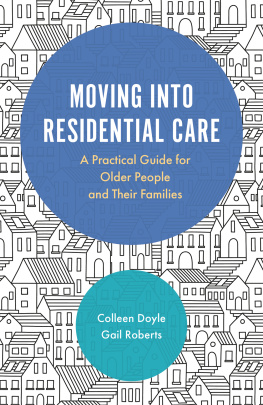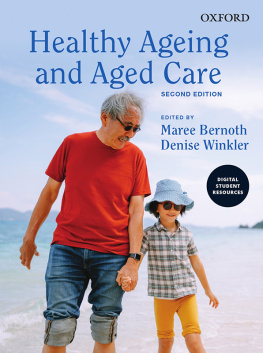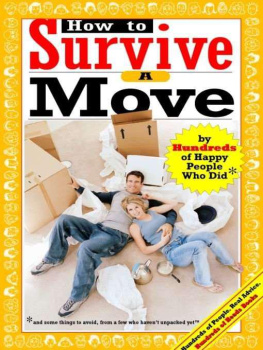
MOVING INTO
RESIDENTIAL CARE
A Practical Guide for
Older People
and Their Families
Colleen Doyle
Gail Roberts

Jessica Kingsley Publishers
London and Philadelphia
CONTENTS
CHAPTER 1
INTRODUCTION
M oving into a residential care home can be one of the most significant life events of later life. The move to a care home may be anticipated or planned by the older person herself/himself in discussion with family or friends. Often it can be unexpected, precipitated by a personal health crisis that requires hospitalisation, and from there it becomes clear that going back home to live independently is not feasible. For others, a slow decline in health may worry relatives and friends, who then pressure the older person to consider moving into full-time care. Occasionally, a person makes the decision to remain in a care home after they have had an enjoyable respite care experience there. Whatever the circumstances, it can be a stressful experience for the person moving to residential care and for their family and significant others, as they leave behind a familiar life, routine and surroundings.
This book summarises the evidence about what the experience of relocating into a care home feels like and what can help to make the change easier, and shares the stories of some people who have experienced it. There are many different terms used internationally in the area of care (see Appendix 2). For ease of reading, we have adopted the term care home to mean care home with nursing or residential care home or nursing home as there are many terms used internationally for the same thing communal living for older people with provision of 24 hour nursing and personal care and social care support. We have also used family to mean family or friends or people who are closely associated with the person moving into the care home. We recognise that many people do not have a close association with their biological family, but friends or others close to them form a family for the person.
We describe the experience of moving into a care home and what new residents and their family can do to ease the transition. We also share the experiences of some residents who recently moved into care homes. While these residents were in Australia, there are many commonalities in the provision of care in other countries, and their stories may resonate with older people experiencing similar transitions elsewhere. We interviewed residents, family members and staff about their experiences and asked them about what helped the adjustment process. The stories show a range of experiences and may help future residents and their family members to understand more about the transition process, and what they can do to best cope with the move. The names used in the stories throughout the book are pseudonyms, and some story details have been changed to protect individual residents anonymity. To illustrate some points, case studies are also included that are a combination of stories from people we have met in the course of our experience in care.
ORIGINS OF CARE HOMES
Residential care has not always been available. The idea of housing set aside for older people who could no longer live independently came about in the 19th century. Until then, it was expected that older people would be cared for by family if they could no longer care for themselves. For the rich, servants could care for them if family were not available. For those alone and poor, the local almshouse was the only choice. In the UK, the 1834 Poor Law gave indoor relief to sick people living in workhouses where men and women were separated, and people worked for the privilege of living there. In 1861, 50,000 people in the UK were housed in the care of a workhouse medical officer (Peace 2003). Later in the 19th century, reforms started to recognise the rights and care needs of the sick, the unemployed and children. From the 1880s onwards, separate care homes developed to care for people with only a modest income. However, the quality of care was low. By the 1920s, even though there were now substantial numbers of nursing homes (26,000 in England and Wales), a Select Committee on Nursing Homes (Registration) reported on the very dire circumstances in which people were living, and subsequently in 1927 the first registration and inspection process was established.
In other countries, similar health, social and care devel-opments were occurring. In Australia, by the early 1900s, resident rights and care needs were beginning to be considered. The state of nursing homes in Australia was highlighted by the Ronalds (1989) report, and subsequently later governments increasingly regulated the provision of care for older people in these settings. Today residential care provision has evolved to the situation where care that is subsidised by government funding is regulated by government agencies that monitor the quality of care. The monitoring process is complex and often criticised because there continues to be a range of quality of care provided.
TERMS USED FOR CARE HOMES INTERNATIONALLY
Nursing home (UK, USA, Canada, Australia, New Zealand) Nursing homes provide 24-hour care for individuals, mostly older people, who are not able to live independently. Services include provision of a room, food, personal care, lifestyle or social, recreational activities, and access to emergency care. Staff profiles vary but generally there are some nursing staff, medical staff on call, regular access to primary health care physicians and allied health services. Many residents receive palliative and end-of-life care within the home. Unlike acute hospitals, there is an emphasis on person-centred care, homelike environments and social relationships to ensure quality of life is high.
Convalescent home Also called sub-acute care or transition care, this is where people can recover from an acute illness or injury for a short time and then return to their own home.
Skilled nursing facility (USA) A nursing home certified to provide Medicare-funded care. Medicare is the US scheme provided for people over 65 who contributed to social security and Medicare during their working life. Medicaid is a programme to provide health care to people with income below the poverty line.
Care home (UK) Previously known as residential homes, care homes provide 24-hour care. In order to enter a care home, an individual needs an assessment of their financial and health status from the local council.
Care home with nursing (UK) Previously known as nursing homes, care homes with nursing provide greater access to nursing care than care homes. Some homes provide both, allowing the resident to age in place as their health deteriorates and they require more assistance.
Rest home (New Zealand) Also known as aged residential care facilities. Access to these homes is through a specialised assessment team.
Intermediate care facility (USA) A place to live for people who are elderly, disabled or living with chronic illness. These facilities usually provide less intensive care than an acute hospital or a skilled nursing facility.
Long-term care facility (Canada) In Canada, long-term care facilities can be private, public or subsidised. The latter two differ only in who owns the facility. Funding, admission and cost to the residents are regulated by the government. Long-term care consists of medical and support services for people who have lost their capacity to live independently.
Board and care home (USA) Sometimes called residential care homes, these places provide assisted living services. Many are small scale, providing accommodation for less than six people. They still offer 24-hour assistance with staff including licensed health care professionals.
Next page







